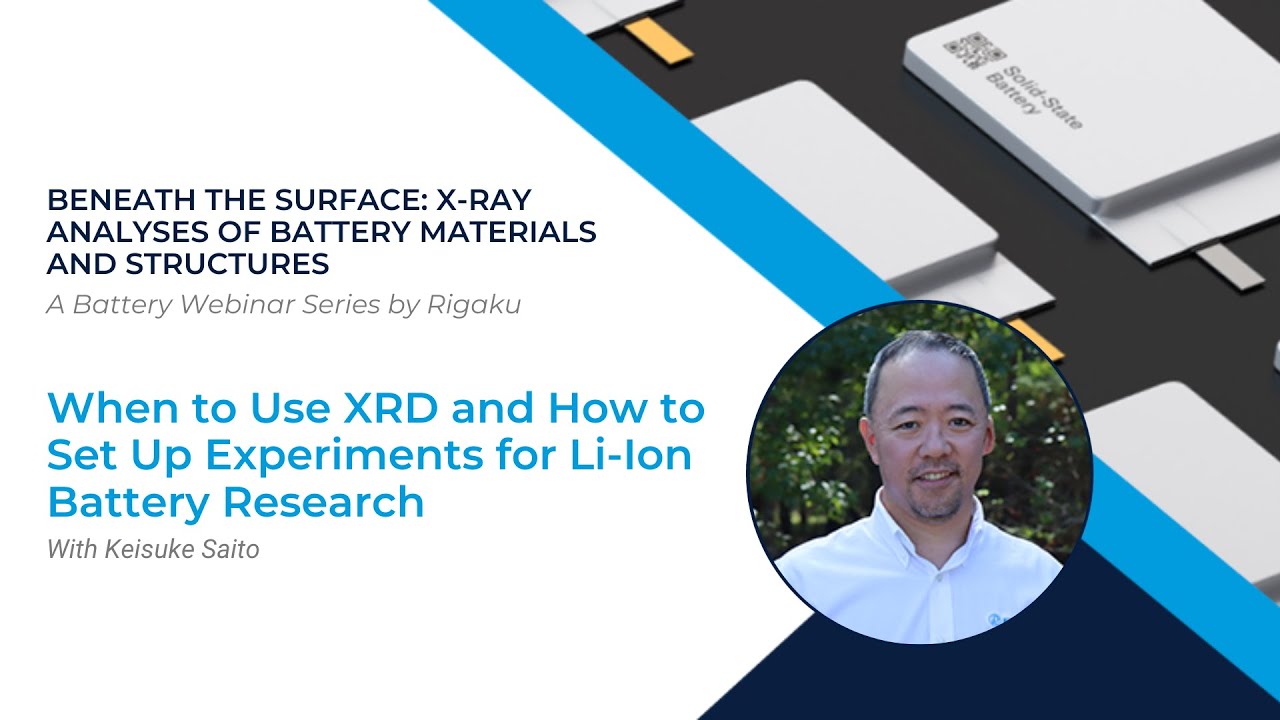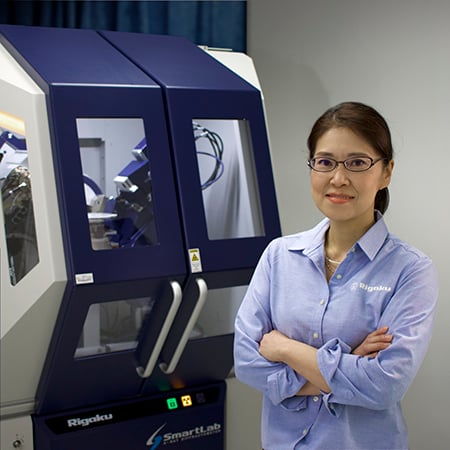Beneath The Surface: X-ray Analyses of Battery Materials and Structures
1. When to Use XRD and How to Set Up Experiments for Li-ion Battery Research

This is a written summary of a live webinar presented on September 20, 2023. The recording and resources are available on the recording page.
Presented by:
Webinar summary
The webinar, part of a series focused on X-ray analysis of battery materials, offers an in-depth, expert-level discussion on how X-ray diffraction (XRD) can be leveraged in lithium-ion battery research. The session opens by distinguishing between static and operando XRD measurements. In static mode, XRD helps identify and quantify crystallographic phases of battery components like cathodes, anodes, and polymer-based separators. The technique provides insight into the lattice parameters, crystallite size, and degree of crystallinity or amorphous content. For polymer separators, XRD can reveal preferred orientation and structural periodicity. The speakers stress that XRD does not detect elemental composition directly but rather crystallographic phases and structural changes.
In operando studies, XRD is applied to complete battery cells (e.g., coin or pouch cells) during charge/discharge cycles, allowing researchers to monitor dynamic structural changes like lattice distortions or phase transitions. Keisuke emphasizes the importance of instrument configuration for data quality, walking through the components of an XRD system: source, optics, sample holder, and detector. He compares two geometries: reflection (typically higher resolution and intensity) and transmission (better for collecting comprehensive data across battery layers but with lower resolution).
Much attention is given to the selection of X-ray sources. Cobalt, copper, and molybdenum anodes offer differing wavelengths and absorption characteristics. Molybdenum, with its shorter wavelength and higher energy, provides better penetration and reduced X-ray fluorescence (XRF) background in transmission measurements, making it ideal for operando studies through battery housings. However, cobalt or copper sources may be better for resolving closely spaced diffraction peaks, especially when higher angular resolution is needed.
The presentation also dives into detector technologies. Modern 2D detectors—particularly those with ultrahigh energy resolution—can dramatically suppress XRF noise and improve peak-to-background ratios. This is crucial when trying to detect weak peaks from trace phases or surface coatings like lithium niobate, which can be obscured by background from lower resolution detectors. The benefits of using 2D detectors also include increased angular coverage, which accelerates data collection for time-sensitive measurements like thermal transformations or operando cycling.
Monochromators, such as multilayer mirrors, are shown to be essential in minimizing background and spectral asymmetry caused by Bremsstrahlung radiation, especially when using high-energy sources like molybdenum. These optical components help isolate characteristic wavelengths and suppress Kβ radiation and Bremsstrahlung tails, which can otherwise mask fine structural details.
The session concludes with a look at specialized sample holders, including airtight designs for air-sensitive materials and various geometries for operando configurations. Keisuke stresses that optimal data quality and meaningful interpretation in battery research require not just choosing the right components, but tailoring the entire setup—from source and optics to detector and sample holder—to the specific experimental goals, whether they be structural identification, quantification, phase tracking, or degradation analysis.
This webinar provides a strategic guide for researchers seeking to extract the most meaningful information from XRD in the context of battery development, diagnostics, and optimization. It is particularly useful for those dealing with advanced materials such as NMC (nickel manganese cobalt oxides), where subtle changes in crystal structure can have significant impacts on performance.
Key questions answered in the webinar
-
X-ray diffraction (XRD) is a powerful analytical technique that uses X-rays to determine the crystallographic phases of materials. Unlike techniques that identify chemical composition, XRD focuses on the crystal structure of a substance. In battery research, XRD is crucial for both static and operando measurements.
For static measurements, XRD analyzes components like cathodes, anodes, separators (if solid), and solid electrolytes. Key applications include:
- Qualitative analysis: Identifying the specific crystallographic phases present (e.g., aluminum oxide, not just aluminum and oxygen).
- Quantitative analysis: Determining the percentage of different phases in a multi-phase sample.
- Lattice parameter refinement and crystal structure refinement: Providing detailed information about the unit cell size (e.g., dimensions along A, B, and C axes) and the positions of atoms within the crystal structure. This can even reveal chemical composition changes if they impact lattice parameters.
- Crystallite size analysis: Determining the size of individual crystalline domains within the material, which is particularly important for nanomaterials as physical and electrical properties are often related to crystallite size. Smaller crystallites typically result in broader XRD peaks.
- Polymer analysis: For polymer-based separators, XRD can analyze preferred orientation, crystallinity (the percentage of crystalline vs. amorphous parts), and long-period structures.
Operando measurements involve real-time XRD analysis during battery operation (charging/discharging cycles). The battery is typically prepared in a pouch or coin cell, and X-rays transmit or reflect through the structure to observe dynamic changes in lattice parameters, crystal structure, or crystallite size as the battery functions. XRD is widely used across the entire battery industry workflow, from raw materials research and R&D to quality control and failure analysis.
-
A typical lab-based X-ray diffractometer consists of an X-ray source, optics, a sample holder on a stage, and a detector.
- X-ray generation: The X-ray source generates X-rays, usually by an electron beam hitting an anode target (e.g., cobalt, copper, molybdenum).
- Beam conditioning: The X-rays are then collimated and, if necessary, monochromated by the optics.
- Sample interaction: The conditioned X-ray beam hits the sample, which is placed in the sample holder.
- Detection: The diffracted X-rays from the sample are recorded by the detector, which measures the intensity of the diffracted beam against the scattering angle (2θ).
An XRD diffractogram plots intensity versus 2θ. This diagram provides a wealth of information:
- Peak width: Broader peaks indicate smaller crystallites, while sharper peaks suggest larger crystallites.
- Horizontal scale (2θ): This information reveals the crystal structure and lattice parameters of the unit cell. For polymers, it can indicate long-period structures. Peak shifts can also be used to quantify chemical composition, especially if it affects lattice parameters (e.g., lithium concentration in lithium cobalt oxide).
- Vertical scale (Intensity): The intensity of the peaks corresponds to the quantity of a specific phase. This allows for quantitative analysis, determining the percentage of different phases, or the percentage of crystalline vs. amorphous content in polymers.
Data analysis typically involves peak searching and profile fitting, followed by comparison of peak information (2θ and intensity) to an XRD database to identify crystalline phases. More advanced applications include Rietveld analysis for detailed crystal structure refinement and the analysis of crystallite size and distribution.
-
The choice of X-ray source, particularly the anode material, significantly impacts the quality and type of data obtained due to differences in X-ray wavelength and energy, as well as power output. Common anode materials for battery applications are cobalt, copper, and molybdenum.
- Wavelength and energy: Shorter wavelengths (higher energy) are generally produced by anode materials with larger atomic numbers (Z).
- Molybdenum (Mo): Provides much shorter wavelengths (e.g., 0.71 Å) and higher energy X-rays. Mo often yields better diffraction intensity because of less absorption and lower 2-theta peak angles (due to the Lorentz factor), leading to higher peak-to-background ratios. This is generally preferred for operando measurements and transmission geometry, especially for pouch cells, as it can better penetrate the battery structure.
- Copper (Cu) and Cobalt (Co): Provide longer wavelengths (e.g., 1.54 Å for Cu, 1.79 Å for Co) and lower energy X-rays. These sources offer higher sensitivity to lattice parameters, meaning small changes in composition or structure that cause subtle peak shifts are more easily resolved due to larger peak separations. While their peak-to-background ratios might be lower than Mo, they are often preferred for high angular resolution studies.
- Absorption and X-ray fluorescence (XRF): When the X-ray source energy is close to the absorption edge of elements in the sample, significant absorption can occur. This leads to:
- Reduced transmittance: Less X-ray signal passing through the sample, which is particularly problematic for transmission geometry (e.g., operando pouch cells). For example, copper X-rays are strongly absorbed by cobalt in LiCoO₂, reducing transmittance.
- High background noise (XRF): The absorbed X-rays can excite characteristic X-ray fluorescence (XRF) from the sample's elements. If these XRF energies are close to the diffracted X-ray energy, the detector cannot easily distinguish them, resulting in a high background baseline that can hide small diffraction peaks. Monochromatization and high-energy resolution detectors are crucial to mitigate this.
- Power: Higher-power X-ray sources (e.g., rotating anode systems offering 9 kW compared to sealed X-ray tubes at 3 kW) provide higher diffraction intensity. This translates to quicker measurements and/or better quality data, leading to more accurate results.
For NMC samples in pouch cells, molybdenum is often the best choice due to its better transmittance and higher peak-to-background ratio, unless very high angular resolution for closely separated peaks is required, in which case cobalt might be an alternative despite lower transmittance and potentially higher background.
- Wavelength and energy: Shorter wavelengths (higher energy) are generally produced by anode materials with larger atomic numbers (Z).
-
The two main measurement geometries in powder diffraction are reflection geometry (Bragg-Brentano) and transmission geometry.
- Reflection geometry (Bragg-Brentano):
- Setup: The X-ray source and detector move relative to the sample, with X-rays hitting the sample surface at varying angles and the diffracted beam being recorded from the same side. The sample is typically placed in a holder in the middle.
- Pros: Generally offers higher resolution and higher intensity compared to transmission geometry. Bragg-Brentano has been established for a long time and still provides the best resolution for powder diffraction. It is commonly used for solid-state battery structures and powdered samples.
- Cons: The X-ray beam footprint on the sample surface can be larger, and the penetration depth of X-rays into the sample needs to be carefully considered. It may not provide information from deeper layers, and one could be misled into thinking a surface measurement represents the bulk or a specific buried layer.
- Transmission geometry:
- Setup: X-rays from the source transmit through the sample (e.g., a pouch cell or coin cell), and the diffracted beam is recorded by a detector on the opposite side. Typically, only the detector scans.
- Pros: Allows X-rays to pass through the entire sample structure. This means it collects diffraction peaks from all layers, including anodes, cathodes, separators, and even the pouch itself. The beam footprint on the sample surface is smaller because X-rays hit perpendicularly. This is particularly advantageous for operando measurements of assembled battery cells, enabling the study of bulk changes.
- Cons: Generally has poorer resolution and lower intensity compared to reflection geometry. Analyzing the data requires filtering out signals from layers not of primary interest. Absorption by components within the battery can be a significant issue, especially for lower-energy X-ray sources.
The choice between these geometries depends on the specific application. For probing surface or near-surface regions with high resolution, reflection is often preferred. For understanding bulk behavior or dynamic changes within an assembled battery, transmission is invaluable.
- Reflection geometry (Bragg-Brentano):
-
Monochromatization is the process of selecting a specific wavelength (or energy) of X-rays from the source, typically using a multi-layer (ML) mirror. It is crucial for improving the quality of XRD data by reducing background noise and enhancing peak-to-background ratios.
- For High-energy X-rays (e.g., Molybdenum, Silver):
- High-energy X-ray sources (e.g., Mo at 60 KV excitation) produce significant Bremsstrahlung (BMS) radiation. BMS is a continuous spectrum of X-rays that creates an asymmetric, high background in the diffractogram, particularly at higher angles.
- Monochromatic focusing mirrors (often elliptical) are used to filter out this continuous radiation, resulting in a much cleaner, symmetric background and improved signal quality.
- For lower-energy X-rays (e.g., Copper, Cobalt):
- While BMS is less pronounced than with higher-energy sources, Cu and Co sources still emit Kβ lines in addition to the desired Kα lines, and also some Bremsstrahlung.
- These higher-energy X-rays (Kβ and some BMS) can excite X-ray fluorescence (XRF) from specific elements in the sample (e.g., iron excited by cobalt Kβ, nickel/cobalt excited by copper Kβ and Bremsstrahlung).
- This XRF contributes significantly to the background noise, potentially obscuring small or weak diffraction peaks.
- Flat ML mirrors are used to remove these unwanted higher-energy components from the incident beam, preventing the excitation of fluorescence background from the sample. This substantially improves the peak-to-background ratio, making it easier to identify and quantify phases, especially trace amounts.
In essence, monochromating the beam ensures that only the desired X-ray wavelength interacts with the sample, minimizing unwanted scattering and fluorescence that would otherwise degrade the quality of the diffraction pattern.
- For High-energy X-rays (e.g., Molybdenum, Silver):
-
Detectors are a critical component of an X-ray diffractometer, capturing the diffracted X-ray signal. Modern detectors can be broadly categorized by their energy resolution and spatial coverage (1D vs. 2D).
- Ultrahigh energy resolution 2D detector:
- 2θ coverage: Large (e.g., up to 15°).
- XRF separation capability (Energy resolution): Very high (e.g., ΔE/E of 4%). This is crucial for suppressing X-ray fluorescence (XRF) background from the sample, making it possible to see small or hidden peaks even with standard configurations.
- Advantages: Excellent for static measurements and identifying trace phases. Its large 2θ coverage allows for faster data acquisition without scanning, making it suitable for operando or in-situ measurements (e.g., temperature-dependent studies). The 2D capability also provides spatial resolution (chi axis), allowing for analysis of powder diffraction rings, spotty peaks from large crystallites, or textured samples.
- Combination: Can be combined with standard Bragg-Brentano configurations.
- High energy resolution 2D detector:
- 2θ coverage: Even larger than ultra-high resolution detectors (e.g., up to 30°).
- XRF separation capability: Good (e.g., ΔE/E of 12%), but less effective than ultrahigh resolution.
- Advantages: Its very large 2θ coverage is highly beneficial for rapid operando/in-situ measurements, as it can capture a wide range of diffraction data without detector scanning.
- Combination: Strongly recommended to be used with a monochromatic beam (Bragg-Brentano for reflection or focusing for transmission) to minimize XRF excitation.
- Normal energy resolution 1D detector:
- 2θ coverage: Much smaller compared to 2D detectors.
- XRF separation capability: Lower (e.g., ΔE/E of 20%).
- Advantages: Was considered good in the past and is still widely used.
- Combination: It is highly recommended to use a monochromatic beam with this type of detector to minimize XRF excitation and improve peak-to-background ratios.
In essence, higher energy resolution detectors (especially 2D) are preferred for battery research because they significantly improve the signal-to-noise ratio by suppressing XRF background, making it easier to resolve weak signals and perform rapid time-resolved experiments. While a high energy resolution detector is considered the most important component for achieving the largest peak-to-background ratio, an ideal setup would incorporate all beneficial components like high-power sources and large 2D detectors.
- Ultrahigh energy resolution 2D detector:
-
Crystallite size is a critical parameter for battery materials because most physical and electrical properties are functions of crystallite size. For instance, nanomaterials, characterized by very small crystallite sizes, have been a popular area of research in the past decade due to their unique properties related to their size. Knowing the crystallite size is essential for predicting and understanding the material properties relevant to battery performance, such as charge and discharge rates, capacity, and cyclability.
XRD determines crystallite size from the width of the diffraction peaks.
- Broader peaks indicate smaller crystallites.
- Sharper peaks correspond to larger crystallites.
After identifying the crystalline phases in a sample, software can perform analysis (often following Rietveld refinement) to quantify the crystallite size and even its distribution (e.g., volume-based or number-based distribution profiles). For example, a sample might be found to have an average crystallite size of 200 Å, with the software providing a probability distribution of different crystallite sizes.
-
"Operando" measurements in XRD refer to in-situ experiments where the battery material is analyzed while it is actively operating (e.g., charging and discharging). This allows researchers to observe dynamic changes in crystal structure, lattice parameters, phase transformations, and crystallite size in real-time, providing crucial insights into the mechanisms governing battery performance and degradation.
For operando measurements, specialized sample holders are designed to facilitate the electrical connection and mechanical stability of the battery while allowing X-ray access. These typically include:
- Pouch cells: These are flexible battery configurations, often made from aluminum, that can be mounted in specific sample holders designed for X-ray transmission. The X-rays transmit through the entire pouch cell structure.
- Coin cells: Small, button-shaped battery cells. Dedicated coin cell holders are available for both reflection and transmission geometries.
- Electrochemical cells: Sometimes referred to generally as "battery cells" or "solid-state battery cells," these are custom-designed cells that allow researchers to assemble and operate various battery chemistries (liquid-based or solid-state) directly within the diffractometer.
- Solid-state battery cells: Some designs allow for pressurization between layers (current collector, anode, solid-state electrolyte, cathode, top current collector) to ensure physical contact, with X-ray windows for analysis. These can also be airtight to protect air-sensitive materials, prepared in a glove box and maintaining the environment for up to 48 hours.
The choice of sample holder often dictates the preferred X-ray source and optics:
- For reflection geometry operando, cobalt or copper X-ray sources are often used.
- For transmission geometry operando (especially with pouch cells), molybdenum or silver X-ray sources are highly recommended due to their better transmittance through the entire battery structure.
Combined with high-area 2D detectors, operando measurements enable rapid data acquisition (e.g., hundreds of measurements in a short time) to capture transient structural changes during battery cycling. Some advanced setups also allow for XY mapping over a pouch cell to observe spatial distribution of phases and changes.

Subscribe to the Bridge newsletter
Stay up to date with materials analysis news and upcoming conferences, webinars and podcasts, as well as learning new analytical techniques and applications.

Contact Us
Whether you're interested in getting a quote, want a demo, need technical support, or simply have a question, we're here to help.


.jpg?width=300&height=300&name=Tim%20Bradow%20(1).jpg)